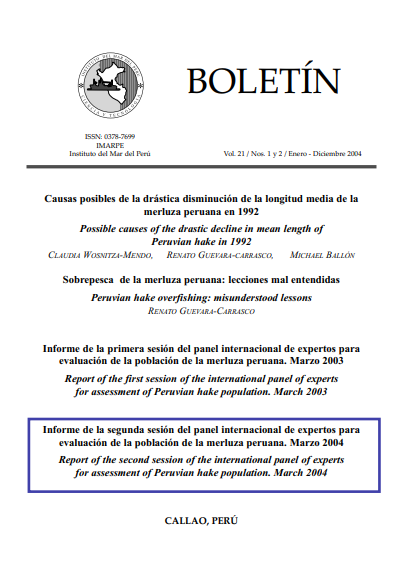Possible causes of the drastic decline in mean length of Peruvian hake in 1992
Keywords:
Peruvian hake, Merluccius gayi peruanus, Length composition, El Niño 1991- 93, Structural changes, Fishing pressureAbstract
WOSNITZA-MENDO C, GUEVARA-CARRASCO R, BALLÓN M. 2004. Possible causes of the drastic
decline in mean length of Peruvian hake in 1992. Bol. Inst. Mar Peru 21(1-2): 1-26.- The drastic decline in mean length of hake in 1992 was, to a certain extent, unexpected by
Peruvian fisheries biologists, accustomed to manage this population as a single stock
and controlling yield and minimum length in catch. During all the decade of the 1980s
fishing effort was not very high and affected mainly age groups IV+. Less than 10% of
the landings were smaller than the mean spawning length of 35 cm. Thus, the numerous
occurrence of small hake in the catches of all the fleets dedicated to this species, starting
in March 1992, seemed to be due to oceanographic conditions, as an El Niño Southern
Oscillation (ENSO) event was going on. Nevertheless, a shift of the whole population
southward and offshore would have been expected, as during former ENSO conditions.
This would mean medium-sized and young hake being farther south out of the range of
the Paita fleet. Against all expectations during the 1991-93 El Niño, due to the intrusion
of subtropical oceanic waters, large hake migrated northward. Yet it seems, that while
the El Niño might have acted as a trigger, the principal underlying cause of the structural changes in the population was the disappearance of the sardine as a prime prey
species for large hake since 1987 onwards, and the lack of small Sciaenidae during the El
Niño for medium-sized hake. The former might be due to heavy fishing on sardine
along with perhaps high predator pressure from a healthy hake population starting
from the mid-1980s. Future studies must include predator-prey relationships in the
ecosystem. These relationships, which evolved over long periods, are probably supporting the stability of the systems, and fisheries captures acting as a strong predator, must
be included in a multispecies model.
Downloads
Metrics
Downloads
Published
How to Cite
Issue
Section
License
Copyright (c) 2004 Instituto del Mar del Perú

This work is licensed under a Creative Commons Attribution 4.0 International License.






